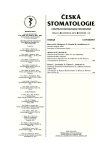Intrusion of Permanent Teeth
Authors:
H. Hecová; V. Merglová; R. Houba; J. Stehlíková
Authors‘ workplace:
Stomatologická klinika LF UK a FN, Plzeň
Published in:
Česká stomatologie / Praktické zubní lékařství, ročník 110, 2010, 6, s. 123-127
Overview
Intrusion of permanent teeth belongs to less frequent but serious injuries. Due to the axial impact at the time of accident the affected tooth is dislocated into the alveolar bone. Periodontal fibers, pulp, cement, alveolar bone and adjacent soft tissues are damaged during the intrusion to various degrees. In the present study analysis of 32 intruded permanent teeth was performed. The aim of the study was to determine the frequency and etiology of intruded permanent teeth and to compare it with success of the treatment in individual ways of reposition. The study revealed that the most frequent cause of intrusion luxation of permanent teeth was falling from the staircase, sport and riding a bicycle. From the total number of dental injuries, having been treated during the observed period at the Stomatology Clinic, Medical Faculty, Charles University in Plzeň, intrusions formed 2.9% of cases. From total of 32 observed teeth, 14 teeth were left without reposition, orthodontic reposition was used in 14 other teeth and in four cases a surgical reposition was made. Vitality of tooth pulp was saved in 6 teeth only, in the remaining 26 teeth there was a posttraumatic necrosis (81.2%). External resorption of the root affected 21 teeth on the whole, while four teeth must to be extracted during the period of observation.
Key words:
intrusion of permanent teeth - posttraumatic necrosis of tooth pulp - resorption of root
Sources
1. Andreasen, J. O.: Etiology and pathogenesis of traumatic dental injuries. A clinical study of 1298 cases. Scand. J. Dent. Res., 78, 1970, s. 329-342.
2. Andreasen, J. O., Andreasen, F. M: Classification, etiology and epidemiology of traumatic dental injuries. In: Andreasen, J. O., Andreasen, F. M..; Textbook and color atlas of traumatic injuries to the teeth. 3rd. ed. Copenhagen, Munksgaard Publishers, 1994, s. 151-177.
3. Andreasen, J. O., Bakland, L. K., Matras, R. C., Andreasen, F. M.: Traumatic intrusion of permanent teeth. Part 1. An epidemiologic study of 216 intruded teeth. Dent. Traumatol., 22, 2006, s. 83-89.
4. Andreasen, J. O., Bakland, L. K., Andreasen, F. M.: Traumatic intrusion of permanent teeth. Part 2. A clinical study of the effect of preinjury and injury factors, such as sex, age, stage of root development, tooth location, and extent of injury including number of intruded teeth on 140 intruded permanent teeth. Dent. Traumatol., 22, 2006, s. 90-98.
5. Caliskan, M. K., Gomel, M., Turkun, M.: Surgical extrusion of intruded immature permanent incisors. Oral Surg. Oral Med. Oral Pathol., 86, 1998, s. 461-464.
6. Kirinos, M. J., Sutcliffe, J.: Traumatically intruded permanent incisors: a study and outcome. Brit. Dent. J.: 170, 1991, s. 144-146.
7. Nelson-Filho, P., Faria, G., Assed, S., Pardini, A. C.: Surgical repositioning of traumatically intruded permanent incisor: case report with a 10-year follow up. Dent. Traumatol., 22, 2006, s. 221-225.
Labels
Maxillofacial surgery Orthodontics Dental medicineArticle was published in
Czech Dental Journal

2010 Issue 6
- What Effect Can Be Expected from Limosilactobacillus reuteri in Mucositis and Peri-Implantitis?
- The Importance of Limosilactobacillus reuteri in Administration to Diabetics with Gingivitis
Most read in this issue
- Enterococcus Faecalis and Its Influence of the Success of Endodontic Treatment
- Intrusion of Permanent Teeth
- Phytotherapeutics and Their Effects of Oral Health
- J. N. Čermák – Physiologist who Contributed to Dentin Microstructure Understanding
